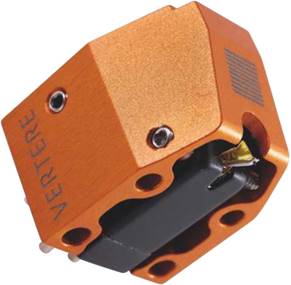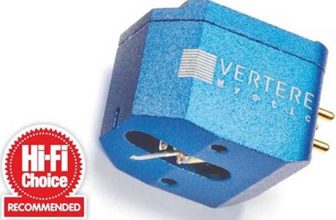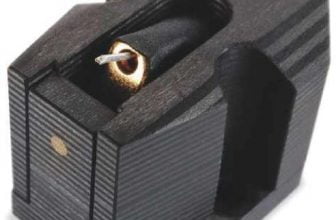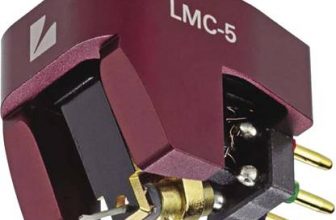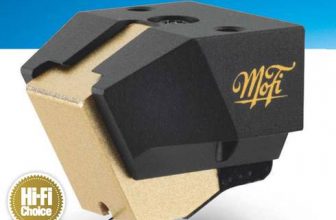Vertere Sabre Review
This Brit-brand’s range of audiophile pick-ups grows yet again with a sub-£1000 model slotting between its entry-level MM and flagship MC. Will the Sabre cut through? Read our Vertere Sabre Review.
Review: Ken Kessler
Lab: Paul Miller
LEFT: The Sabre has a two-part body with the inner (black) MM mechanism clamped in place within the bold orange alloy shell via four M2.5 Allen-headed ‘spike’ bolts
Made by: Vertere Ltd, london
Supplied by: Vertere Ltd
Telephone: 0203 176 4888
Web: www.vertereacoustics.com
In the heated-up marketplace that is ‘LP Playback Circa 2022′, and as with the ModWright PH 9.0 phono stage [p62], we are also experiencing a surfeit of cartridges, tonearms and decks. With so crowded a playing field as this, Vertere – about as iconoclastic a manufacturer as analogue has seen in recent times [see PM’s boxout, below] – has to make its Sabre cartridge stand out from the rest. The company has chosen to address a usually neglected niche: true high-end moving-magnet designs.
Its £ tariff might seem low compared with contemporary moving-coils but, for a variety of reasons, MCs have typically always been pricier than MMs. Yet Vertere’s Sabre highlights the virtues of a fine MM – superior tracking, a usefully high output, and universal 47kohm loading.
EASTERN PROMISE
That said, Vertere still has to justify a price that would pay for any of a number of excellent MCs, such as the EAT Jo No5 [HFN Dec ’18]. Hence, this is no badge- engineered, re-bodied MM from a major supplier, which is the easy way out. Instead, like Ferrari fitting brakes from Brembo, the Sabre comprises carefully- specified, proprietary components from two of Japan’s top OEM suppliers – one for the micro-elliptical stylus, aluminium cantilever and suspension, and another for the Alnico magnet/coil ‘motor’. These form the innards, which are housed in one of the most impressive bodies I’ve seen, reminding me of the early Lyras. Coloured a bold orange, it is CNC-machined from aluminium alloy, promising a constructional integrity that’s the antithesis of moulded plastics. Despite this, the entire cartridge weighs a shade over 10g, which won’t cause problems for too many tonearms. To provide context, that’s still 2g less than one of the covetable stone bodied Koetsus [HFN Nov ’17].
Thanks to the strength of this shell, the internals are able to be bolted into place with four ‘spike’ screws, the heads visible and reassuring, while eschewing any adhesives which can (and do) age. It’s a resonance killer, imparting a sense of solidity that’s as satisfying as tyre-kicking. And it’s not just for looks – rather, it enables a certain type of fetishist to tighten those screws without worrying about deforming the body. This is as far removed from the classical open-slot fixing of my beloved Denon DL-103 moving-coil [HFN Jul ’09] as it gets.
TURNING THE SCREW
It’s all about the details. The top plate features raised areas to enable a ‘three- point’ contact with the headshell, a favoured practice among cartridge aficionados which is said to ‘provide the exact mechanical coupling required’. Further to ensuring a tight fit are stainless steel thumbscrews included in the clever packaging, which hold the Sabre in place while in transit [see inset picture, p50].
The very esoteric Reference TA tonearm broke cover in Jan ’13 at CES, followed later that year by the RG-1 (Reference Groove) and SG-1 (Super Groove) turntables. These flagships sent a message of intent and were not only instrumental in realising the more affordable MG-1 (Magic Groove) but also in establishing working relationships with mastering engineers including Miles Showell [Opinion, HFN Apr ’20] and Giles Martin [Investigation, HFN Nov ’17]. Vertere’s most recent deck, the DG-1 [HFN May ’20] is joined by no fewer than three pick-ups, including the Sabre MM pictured and reviewed here.
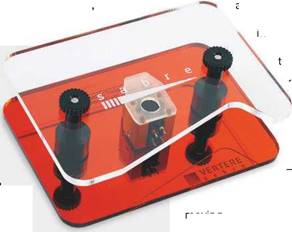
Those same thumbscrews can be used to fix the cartridge to the headshell or tonearm, and they do look impressive as hell in situ. The Sabre also comes with the best stylus guard ever, which clips into place with four pegs that correspond to the four holes in the body’s underside.
Everything about this cartridge suggests concern for the user, because it’s one of the easiest to install that I’ve come across – and I reckon I must have fitted in excess of two thousand. In addition to transit screws which double as overkill headshell bolts, the back has colour-coded, nicely spaced pins. The only slight fiddle was that these pins are small, so I had to pinch the tags on the headshell leads.
Alignment was a doddle, thanks to the Sabre’s parallel sides, markings on the front facet to act as visual aids, and a cut-out allowing a full view of the stylus and cantilever for positioning on a protractor. The pick-up’s side view is just as accommodating, and I found VTA to be (sonically) optimum with the top of the cartridge absolutely parallel to the LP surface.
Tracking force was set to 2g, and it never misbehaved [see PM’s Lab Report, p53], even at the inner points with some deep-grooved, overly-modulated 12in singles. In other words, it behaved like a classic top-of-the-range MM, a la the venerable Shure V15s, but without emulating their now-out-of-fashion 1g downforce. Moreover, I had no trouble with four different phono stages’ 47kohm inputs, but it was interesting to note that the Sabre responded audibly to capacitance adjustments if your phono stage supports this.
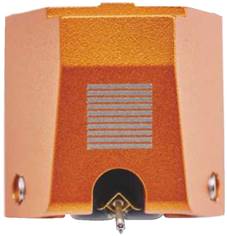
ABOVE: Seen end-on emerging from its protective sleeve, the stylus is mounted right through the crimped end of the alloy cantilever
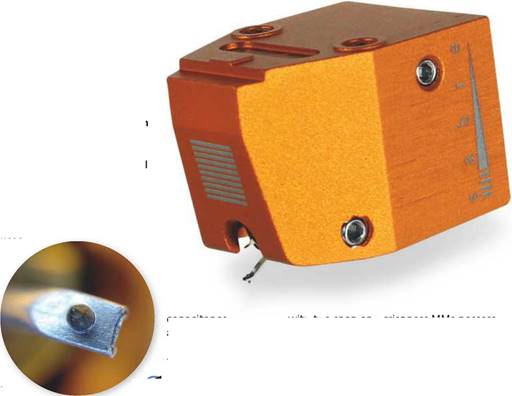
Threaded (M2.5) inserts run through the body allowing the Sabre to be firmly mounted to a headshell. Note three-point contact
Micrograph reveals a shank very neatly mounted through the crimped alloy cantilever and tipped with a first- class 7.5×15.5pm elliptical stylus
SABRE DANCE
It’s not like I’ve been listening only to moving-coil cartridges of late, having used three different Ortofons, a bunch of Deccas/Londons, and a few vintage MMs during the past year alone. But the Sabre immediately stood out from all of them because of an unexpected silkiness that I’d usually associate with vintage Denon and Ortofon MCs. Apparent even with recordings which do not necessarily command such an attribute, including the raucous, eponymous debut from the J. Geils Band [Speakers Corner/Atlantic SD8275], the trait was detectable and repeatable.
Throughout the album, Magic Dick’s harmonica playing cuts through every number, and here it exhibited a freedom from the edge which drives some people away from that instrument. It might be argued that the cutting effect is as essential to blues harp as a rattling sound is to banjo, but instead it made it sound more immediate. A similar effect was evident with Peter Wolf’s vocals, the inimitable style of rapper/DJ/blues belter on ‘Pack Fair And Square’ enjoying an in-the- room presence free of artifice.
‘It enjoys an in-the-room presence free of artifice’
What dazzled most were the soaring guitar notes, Geils himself tearing off hot licks that challenged the Sabre’s speed, to which it responded exactly as I expected: with the snap and crispness MMs possess in spades. While not quite as crystalline as a Decca/London at its best, the superlative treble extension and rapid transient attack complemented the smoothness of the rhythm section, especially the bass guitar.
Sticking with excess, The Dave Clark Five’s All The Hits [BMG CAT408DLP] provided one of the cleanest versions available of ‘Glad All Over’, which reinforced my notion that the Sabre runs pretty damned close to a good MC for the sheer mass of overloaded bass and percussion. This track means nothing without the sensation that a herd of wildebeest are stomping on a wooden floor, and the Sabre managed to deliver exactly the pile-driver effect that suggests a dancehall full of drunken mods in 1964.
TASTE THE DIFFERENCE
Where it differs from like-priced movingcoils in this area is that the bass drum sound is drier, and a touch tighter. Which is the more correct I could not say, but I proffer that it’s a perfect example of how personal taste or preference should always be the final arbiter. I can only imagine the sense of enlightenment one might experience if mystified by the MM-vs-MC debate, because this cartridge, for all of its MC-like strengths, remains definitively a moving-magnet by nature.
Ultimately, this lower octave behaviour would be determined by the rest of the system, as this cartridge – played through both dynamic ported speakers and small ribbon-tweeter-equipped dipoles – cannot be expected to counter the differing natures of, say, speaker types, or tube electronics versus solidstate, beyond fine-tuning. But my conclusion that the Sabre’s bass is – in general – drier than that of a stereotypical MC was arrived at after playing through two entirely different systems. It was consistent from LP to LP, system to system, and it proves to be as much a descriptor of the Sabre’s character as the aforementioned silkiness.
A DATE WITH DUSTY
Leaving the in-your-face recordings for something more subtle, and, I must admit, more MC-oriented, I wallowed in the marvellous ‘various artists’ set, The Wonderful Sounds Of Female Vocals [Analogue Productions APP122]. I have at least a dozen versions of Dusty Springfield’s ‘Son Of A Preacher Man’ and ‘The Look Of Love’, the latter even on open-reel tape, but this pressing ranks with the best.
It was a perfect choice to hear how the Sabre dealt with Dusty’s inimitable breathy delivery, a fragile element of a peerless instrument which made her singing instantly recognisable. What impressed as much as the airiness reproduced by the Sabre was the presentation beyond the singer herself: this cartridge delivers one of the widest soundstages I have heard from any below a grand. I had just been using the traditional MC champ, my Denon DL-103, and could actually measure with a mental rule a reduction of less than what? Five per cent of the stage width?
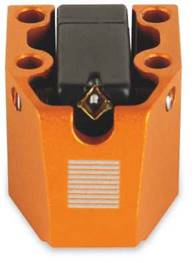
Four holes are drilled through the alloy body to reduce overall weight, while the two at the front are threaded. Cartridge pins are usefully spaced and clearly colour-coded
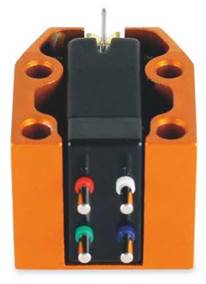
The Sabre’s body profile makes for simplified alignment and very easy cueing by eye in regular use
This further reinforces Vertere’s desire to present a moving-magnet cartridge as a high-end transducer worthy of the respect afforded to MCs. So it’s time for a bit of grownup behaviour. The axes that fought the tubes-vs-transistors battle which raged for decades have long been buried, as have arguments about direct-drive-vs-belt-drive. I’m not suggesting for a second that the Sabre cancels out the rivalry, but it certainly makes it more difficult to proselytise blindly (or should that be deafly) that all MCs automatically slaughter all MMs. This cartridge proves otherwise.
VERDICT
LAB REPORT
Joining that rarefied club of ‘high-end’ MM pick-ups, the Sabre makes a compelling case for the genre. Rated at 4mV (re. 1kHz/ 5cm/sec), the Sabre’s delivery is healthier still at 4.95mV, putting it right up with the beefiest of Ortofon’s longstanding 2M series [HFN Oct ’08, Mar ’11 and Jun ’21]. The channel balance is below average at 0.9dB (left channel higher than the right here) but stereo separation is exceptional at >30dB through the midrange. Neither is the compliance quite as ‘stiff’ as its rated 10cu might suggest. In practice the suspension is a softer 15cu, rendering the Sabre’s 10g bodyweight better suited to low/medium mass tonearms while also aiding its tracking performance. It holds tight to ~75 muym via the left/right channels while just nudging over 1% THD through the toughest +18dB groove modulation (re. 315Hz/5cm/sec) – at 2g downforce it will surely remain secure through the most ferocious of grooves!
An alloy pipe cantilever remains common in MM designs where, in more sophisticated designs, the resonance of the tube and finite mass of the stylus may be employed constructively to ‘tune’ the HF response of the generator mechanism. So it is here as the mechanism offers fine vertical/lateral symmetry [red/black traces, Graph 1] – promising a uniform soundfield – while the loss in presence output and HF roll-off is countered by a boost at 13-14kHz. Equalised distortion is similarly ‘symmetrical’ but rises to ~12% around 6-7kHz [stereo trace, Graph 2; -8dB re. 5cm/sec] as the 2nd harmonic coincides with this peak in output. The drop in distortion above 10kHz simply reflects the loss in the Sabre’s higher treble output [Graph 1]. Finally, the Sabre’s unspecified VTA looks close to 26o – an ‘average’ figure these days. PM
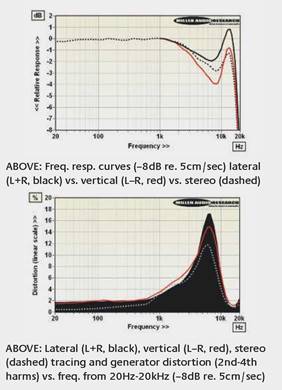
SPECIFICATIONS
| Generator type/weight | Moving-magnet / 10.3g |
| Recommended tracking force | 19-21mN (20mN) |
| Sensitivity/balance (re. 5cm/sec) | 4.95mV / 0.9dB |
| Compliance (vertical/lateral) | 15cu / 14cu |
| Vertical tracking angle | 26 degrees |
| L/R Tracking ability | 75 muym / 75 muym |
| L/R Distortion (-8dB, 20Hz-20kHz) | 1.3-11.8% / 1.1-10.5% |
| L/R Frequency resp. (20Hz-20kHz) | + 0.1 to -12.1dB / +0.1 to -10.9dB |
| Stereo separation (1kHz / 20kHz) | 36dB / 24dB |
